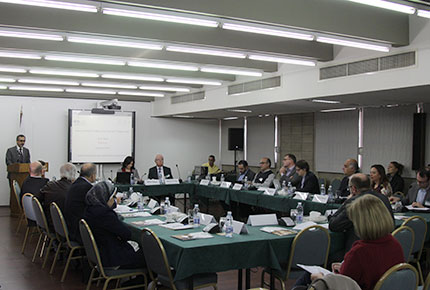Can we exit the warzone?
LAU hosts conference of international experts to discuss ways of putting an end to the violence that is rocking the Middle East.
How can we explain the increasing outbreak of wars in the region in the aftermath of the “Arab Spring?” What can we learn from former wars to end the current ones? These are some of the questions that the international community is asking itself in the light of the current spiral of violence in the region.
On November 12 and 13, LAU hosted a conference under the title “Wars and Wars’ Ending in the Post-2011 Middle East,” in collaboration with the German Institute of Global and Area Studies (GIGA). Welcoming a group of international guests and regional experts, the Dean of the School of Arts and Sciences Nashat Mansour defined Lebanon as “one of the best laboratories of conflict in the world” and remarked that, for the first time, the country is playing the role of spectator.
The national and regional history and present situation was analyzed by Senior Associate at the Carnegie Middle East Center Maha Yahya, who rejected the idea that the area is experiencing an “Armageddon,” as some have defined it. Yahya nonetheless stressed the need to end the violence that has spiraled seven of its countries into armed conflicts.
While the picture is bleak, Yahya noted the positive trends that have emerged in the region since 2011. “Citizens were used to being considered threats to the state security, while now they have reasserted the role of citizens as the source of legitimacy,” she said, claiming that now there is an increased understanding of the power of individuals. The challenge ahead will be reestablishing national social contracts now that states are fragmented according to local affiliations.
Drawing from the Lebanese experience, Associate Professor of political science and international affairs Makram Ouaiss discussed possible exit strategies to the present armed conflicts by examining the usefulness of third parties in reaching a diplomatic solution. According to his analysis, there are a series of conditions that must be fulfilled in order for mediation to be successful, namely self-interest, a mutually painful stalemate and the ability of both parties to visualize the possibility of a better outcome through mediation.
As it was for Lebanon with the Taif and the Doha agreements, diplomatic efforts have to translate into concrete acts. However, Ouaiss does not foresee Syria will reach a similar outcome in the near future. “Options are quite limited because there is no indication that any of the parties involved are willing to push in the right direction,” he says. “On the contrary, there is the rejection to engage completely with certain political parties.” Alternatives include financial incentives, but Ouaiss underlines that this option’s feasibility has yet to be fully explored.
GIGA’s Stephan Rosiny asked how well-designed power sharing can end sectarianism, following the surge of sectarian identities as the main fault lines in the conflicts that are currently reshaping the Middle East. “Power sharing is not a technique to overcome sectarianism but rather an institutional design to overcome this kind of conflicts,” he says, proposing a unitary nation state as the ideal political structure. In his concluding remarks, Rosiny advocated the necessity of a transitional phase, based on consociationalism, on the way to a system based on nationalism rather than sectarianism.
More
Latest Stories
- Into the Psychology of Justice
- Alumnus Zak Kassas on Navigation, Spoofing and the Future of GPS
- Hearing Between the Lines
- LAU Hematology Conference 2025: Advancing Science Through Interdisciplinary Exchange
- Dr. Chaouki T. Abdallah Invested as LAU’s 10th President
- LAU Guides Its Students Through the Code of Conduct
- Innovative Procedure at LAU Medical Center–Rizk Hospital Signals Hope for a Patient With a Congenital Disease
- LAU’s Inaugural PodChat Session Addresses AI Detection in the Classroom


